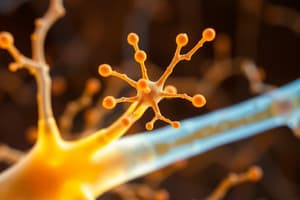Podcast
Questions and Answers
¿Qué función desempeña la corteza somatosensorial secundaria (S2)?
¿Qué función desempeña la corteza somatosensorial secundaria (S2)?
- Ayudar a mantener el equilibrio y coordinación del cuerpo.
- Procesar información básica del sistema somatosensorial.
- Interpretar y analizar los datos enviados por la corteza somatosensorial primaria (S1). (correct)
- Crear un mapa del cuerpo llamado homúnculo sensorial.
¿Cuál es la función principal de los propioceptores en el cuerpo humano?
¿Cuál es la función principal de los propioceptores en el cuerpo humano?
- Crear una división entre la corteza somatosensorial primaria y secundaria.
- Procesar la información sensorial recibida del entorno.
- Proporcionar retroalimentación constante al sistema nervioso central sobre la posición y movimiento del cuerpo. (correct)
- Proporcionar un mapa del cuerpo conocido como homúnculo sensorial.
¿Qué caracteriza a los fascículos dentro del sistema nervioso central?
¿Qué caracteriza a los fascículos dentro del sistema nervioso central?
- Se encargan de procesar la información sensorial básica en el cerebro.
- Son colecciones de tejido cerebral en el encéfalo.
- Conectan la corteza somatosensorial con los músculos y articulaciones.
- Permiten la transmisión rápida de señales eléctricas entre diferentes partes del sistema nervioso central. (correct)
¿Cuál es la traducción más cercana de 'Encephalo'?
¿Cuál es la traducción más cercana de 'Encephalo'?
¿Cuál es la función principal de la médula espinal en el sistema nervioso?
¿Cuál es la función principal de la médula espinal en el sistema nervioso?
¿Cuál de las siguientes afirmaciones sobre los receptores sensoriales es correcta?
¿Cuál de las siguientes afirmaciones sobre los receptores sensoriales es correcta?
¿Qué sucede después de que los receptores sensoriales se activan?
¿Qué sucede después de que los receptores sensoriales se activan?
¿Cuál de las siguientes estructuras NO forma parte del sistema somatosensorial?
¿Cuál de las siguientes estructuras NO forma parte del sistema somatosensorial?
¿Qué información proporciona el sistema somatosensorial?
¿Qué información proporciona el sistema somatosensorial?
¿Qué tipo de receptores sensoriales detectan cambios en la temperatura?
¿Qué tipo de receptores sensoriales detectan cambios en la temperatura?
Flashcards are hidden until you start studying
Study Notes
Understanding the Somatosensory System
The somatosensory system is a crucial component of the human nervous system responsible for processing various sensory information from the skin and internal organs. It consists of specialized receptors, afferent pathways, a processing center called the somatosensory cortex, and other related structures. In this article, we'll explore these components and their roles in allowing us to sense and perceive the world around us.
Receptors
Sensory receptors play a vital role in converting physical stimuli into electrical signals. They are located throughout the body and are sensitive to different types of stimuli, including pressure, heat, cold, and pain. Mechanoreceptors detect mechanical forces applied to the skin, muscles, joints, and inner ear, providing information about touch, movement, and position. Chemoreceptors identify chemical stimuli such as pH and glucose levels, while thermoreceptors responds to changes in temperature. Finally, nociceptors, or pain receptors, detect harmful stimuli and relay them to the central nervous system.
Afferent Pathways
Once activated, sensory receptors generate electrical signals called action potentials. These signals travel along specialized nerve fibers called axons to the spinal cord, where they synapse onto neurons. From here, the signals ascend through the spinal cord and enter the brainstem. Within the brainstem, the signals are routed to specific areas of the cerebral cortex, depending on the type of sensory input received.
Somatosensory Cortex
Located in the parietal lobe of the brain, the somatosensory cortex is a critical component of the somatosensory system. It processes the sensory information received from the periphery and is divided into two main regions: the primary somatosensory cortex (S1) and the secondary somatosensory cortex (S2). S1 is responsible for processing basic sensory information, while S2 helps to interpret and analyze the data sent by S1. Both regions contribute to creating a 'map' of the body, called the sensory homunculus, which reflects the relative proportion of sensory innervation in different parts of the body.
Proprioception
Proprioception refers to our awareness of the position and movement of our own body in space. Proprioceptors, located throughout the body, especially in muscle spindles, Golgi tendon organs, and joint capsules, provide constant feedback to the central nervous system, helping us maintain our balance and coordination.
Fascículos, Encephalo, Medulla Espinal
These terms refer to different aspects of the central nervous system and neural pathways.
- Fascículos: Also known as white matter, fascículos are collections of myelinated axons that allow rapid transmission of electrical signals between distant parts of the CNS.
- Encephalo: Translated from Latin, meaning "head" or "brain," this term refers to the collection of tissues comprising the brain and spinal cord.
- Medulla Espinal: Known as the spinal cord in English, the medulla espinal is a long, cylindrical bundle of nerve tissue running down the length of the spine. It connects the brain to the rest of the body, transmitting motor commands and sensory information.
Understanding the somatosensory system and its components is essential for comprehending how we perceive the world around us.
Studying That Suits You
Use AI to generate personalized quizzes and flashcards to suit your learning preferences.




